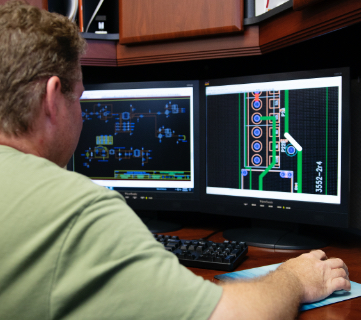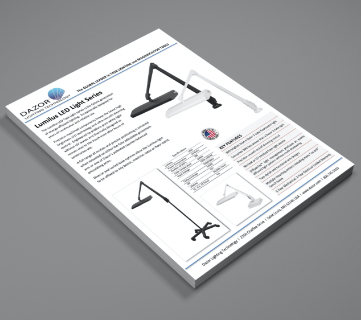Task Lighting FAQs
What is "task lighting"?
Task lighting refers to any light source designed specifically to direct light onto some "task" performed by a person or machine.
What are the primary benefits of task lighting?
Task lighting can:
- Increase productivity
- Improve personal viewing comfort
- Provide greater control of individual lighting levels
- Save energy dollars
How can task lighting increase our productivity?
Do you realize how much more comfortable task lighting makes our jobs? Have you tried it? A recent study by the American Society of Interior Designers found that poor lighting and eyestrain are the most frequent office worker complaints.
We must be comfortable to maintain productivity over the course of a day. There are enough demands and distractions that compete for our energy and concentration. Straining to see should NOT be one of them. Seeing should be effortless and automatic. We spend a great deal of time and money trying to make ourselves more comfortable so that we can be more efficient and productive. Yet frequently, we neglect a simple and inexpensive solution - a task light.
What is the advantage of an adjustable-arm task light?
Personal control. We can adjust the level of light for our individual viewing comfort. Our posture changes during the day. Our tasks vary to some degree. If we have windows, light in the room changes from morning to evening. In response to these changing conditions, we need to be able to adjust the lighting levels directed on our work in order to maintain maximum performance. Task lighting allows us to correctly position the angle of light to eliminate glare and veiling reflections.
Do we need a task light if we have magnification?
Definitely. Magnification is only half of the solution for achieving good vision. Proper lighting is of equal importance. Take an extreme example. How much good would magnification do in the dark? Not much. The benefits derived from visual aids such as magnifiers and prescription glasses are entirely dependent upon the lighting conditions in which they are used. Proper task lighting allows us to get the maximum benefit from a visual aid, and may even allow for reduced magnification. Increasing the amount of light (brightness) directed onto a task will help compensate for small print size or poor contrast. Examples of poor contrast include faded print on white paper, or dark print on a dark background.
Is it true the older we get, the more light we need?
Yes. The older we get, the more light we need to see. Research indicates that people in their 60's need 80% more light for reading than people in their 20's. This increased need for light is due to a number of biological facts in the aging process. For example, the muscle in our eye called the iris, expands and contracts to control the amount of light entering our eye. As with all our muscles, the iris loses some of its flexibility in the aging process, and doesn't open as wide. Therefore, more light is needed to compensate for the reduced ability of the iris to open wide.
How can task lighting save energy and money?
Instead of trying to maintain proper lighting levels on desktops from overhead fixtures, task lights can do a better job while using less energy. A task light using the new 13-watt compact fluorescent lamp will consume far less energy than a typical overhead lighting fixture. A work environment can maintain lower levels of overhead lighting by illuminating desktops with energy-efficient task lights. In addition, maintenance and bulb replacement costs are less with task lighting.
Why is LIGHT important for good vision?
Our ability to see depends upon two factors: (1) proper functioning and focusing of our eyes and, (2) the amount and quality of the light that is reflected from the object back into our eyes. The poorer the lighting, the less light will be reflected from the object back into our eyes. We can't see in the dark - but as the amount and quality of light improves, the better we can see.
I have a TABLE LAMP with a SHADE. Isn't that enough?
In most cases a table lamp with a soft shade is not suited for doing tasks that require seeing small details, such as reading or cross-stitch. Table lamps are designed to look pretty with your furniture and give a soft, warm glow. The shade diffuses the light and prevents more intense, focused light from reaching your task.
Can CEILING FIXTURES provide the proper lighting?
Ceiling Fixtures are designed to give overall illumination to a room. By the time the light travels the distance from the ceiling fixture to table level, it becomes unfocused and too dim for seeing small details. Putting brighter, higher wattage lamps in the ceiling fixtures is not an economical solution because it increases your electric bill!




